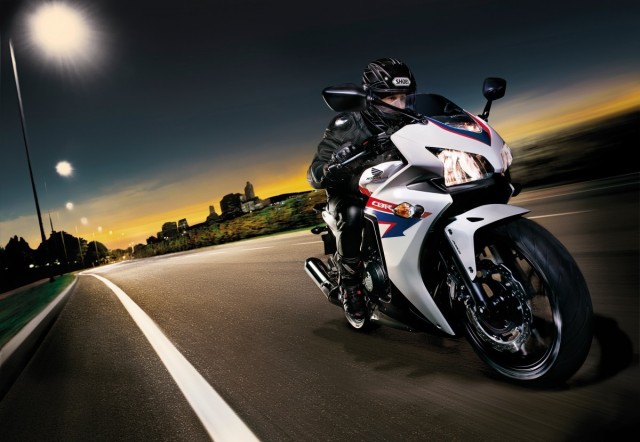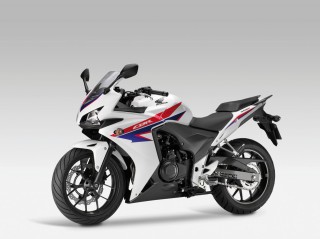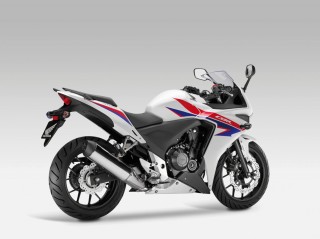Honda’s first parallel twin cylinder was the engine in the 1957 247cc Dream C70. Honda says the CBR500R carries the CB badge inspired by the DOHC CB450 twin of the 1960s that often outperformed larger capacity rivals.
The CBR500R uses a 35mm diameter steel diamond tube frame. Mass centralisation, as is the norm these days is they keyword. The engine is mounted very close to the swingarm pivot point that results is agile handling. Optimum front/rear weight distribution ensures stability. With a kerb weight of 194kg the CBR500R shouldn’t be too heavy to handle and with a seat height of 790mm stamps its authority as the definitive beginners bike that does not rob you of the fun factor. Honda says the handle bar position is relatively high making it more a Kawasaki Ninja 650 alternative.
The fuel tank has a capacity of 15.7 litres, including reserve. With a specified fuel economy of 27kpl, Honda says this should give the motorcycle a range of 420km.
Lightweight, 17-inch cast aluminium wheels employ hollow cross-section Y-shaped spokes. When it is launched in India, it will do well to cater to the needs of the I-need-a-really-wide-tyre enthusiasts in our country. The front tyre is a 120 section and the rear a 160 section. A single front 320mm wavy disc and two-piston brake caliper takes care of braking up front and a 240mm rear disc and single-piston caliper. ABS is fitted as standard but we wouldn’t be surprised if two variants are offered in India with ABS being optional.
The comprehensive dash features a digital speedometer, digital bar graph tachometer, odometer, dual trip meters, clock, plus digital fuel level gauge and fuel consumption. HISS (Honda Intelligent Security System) is built in to the ignition, and the headlights feature two 55W H7 Halogen bulbs and multi-reflectors.
Engine
The engine has our curiosity piqued. What did Honda do? Did they take two CBR250R powerplants and mash them together? Or was it a bigger capacity engine that was chopped down? While it was initially rumoured that it was actually two 250 engine powerplants combined, it would now seem that this engine shares more with the CBR600RR engine.
The bore x stroke of the CBR500R is 67 mm x 66.8 mm. The bore size of 67mm is identical to that of the CBR600RR. The ‘triangle’ proportion of crankshaft, main shaft and countershaft is very similar to that of Honda’s four-cylinder RR engines and this is what makes the CBR500R engine a very compact unit. The six-speed gearbox also draws more from the bigger RR cousins that allows for a short engine and uses the same gear change arm structure and link mechanism.
The DOHC, 8-valve liquid-cooled parallel twin layout was chosen because of its light weight, all-round ability and flexible usability. The crankshaft pins are phased at 180° and obviously results in a 180° phased firing order. A primary couple-balancer sits behind the cylinders, close to the bike’s CG. The primary and balancer gears use scissor gears to reduce reducing noise says Honda. The crank counterweight is specifically shaped for couple-balance and its reduced weight allows the engine to spin freely, with reduced inertia.
The shape of the piston was based on those used in the CBR1000RR. Honda says this would help reduce piston noise since the peak rpm was going to relatively high. Friction is reduced by the addition of striations on the piston skirt. These striations increase surface area by introducing gaps in which oil can flow for better lubrication. As with the CBR600RR and CBR1000RR, an AB 1 salt bath process, used after isonite nitriding, forms a protective oxidisation membrane.
The crankcase uses centrifugally-cast thin-walled sleeves, and with the same bore interval as the CBR600RR helps them be as compact and light as possible.The internal design also works to reduce the pumping losses that can occur with a 180° phased firing order. Using the same internal relief structure as that of the CBR1000RR, the oil pump features improved aeration performance, with reduced friction and allows use of a simple oil pan.
The engine itself acts as a stressed member, reinforcing the frame’s rigidity with four frame hangers on the cylinder head. A secondary air injection (AI) system is built into the cylinder heads, while an 02 sensor and catalyser inside the 2-1 exhaust work to ensure the CBR500R’s emissions are extremely low.
Honda’s proprietary PGM-FI fuel injection provides good throttle response and the peak power of 35kW/47bhp arrives at 8,500rpm, with 43.1Nm torque delivered at 7,000rpm. The differences from the elder siblings start showing here. While the CBR600RR uses Dual Stage Fuel Injection (DSFI) and the CBR1000RR uses Programmed Dual Stage Fuel Injection (PGM-DSFI) but the CBR500R has to be content with the PGM-Fi mill we’ve grown accustomed to on the Hondas and Hero Hondas in India. The compression ratio on the CBR600RR is around 12.2:1 and 12.3:1 on the CBR1000RR while the CBR500R and CBR250R share a compression ratio of 10.7:1
If anybody is interested, the crankcase and cylinder are finished in what Honda calls Matt Axis Grey Metallic finish.The colour Honda says, adds depth, complementing the CBR500R’s taut overall styling.
The CBR500R will also be the motorcycle of choice for the European Junior Cup. Young riders from 14-19 years, based in countries from Europe to Asia as well as the USA and Australia, will be racing to win a ride throughout 2014 for a Honda team in the UEM Superstock 600 European Championship.
Price
In the US the CBR250R ABS retails for around $4699, an equivalent of INR 2.6 Lakhs before taxes, while in India it is much cheaper thanks to localization. The CBR500R is priced at 5,999$ an equivalent of INR 3.3 Lakhs. This should, in an idealistic world, mean a slight premium over the 250R even in the Indian market. However, we doubt if HMSI will adopt the same strategy for the CBR500R which is bound to be looked upon as a niche product with much less volumes. We disagree. We think the CBR500R could be sold at a price point anywhere between 2.5 to 3.0 Lakhs and still garner enough volumes justifying an assembly line, considering it has the badge value – of being a 500cc motorcycle. Of course, this is the Indian market we are talking about, we might end up being entirely off the target.
Technical Specifications
ENGINE
| ENGINE | ||
|---|---|---|
| Engine Type | 500cc liquid-cooled parallel-twin | |
| Bore And Stroke | 67.0mm x 66.8mm | |
| Induction | PGM-FI with 34mm throttle bodies | |
| Ignition | Computer-controlled digital transistorized with electronic advance | |
| Compression Ratio | 10.7:1 | |
| Valve Train | DOHC; four valves per cylinder | |
DRIVE TRAIN
| DRIVE TRAIN | ||
|---|---|---|
| Transmission | Six-speed | |
| Final Drive | O-ring-sealed chain | |
CHASSIS / SUSPENSION / BRAKES
| CHASSIS / SUSPENSION / BRAKES | ||
|---|---|---|
| Front Suspension | 41mm fork; 4.8 inches travel | |
| Rear Suspension | Pro-Link single shock with nine-position spring preload adjustability; 4.1 inches travel | |
| Front Brake | Twin-piston caliper with single 320mm wave disc | |
| Rear Brake | Single-caliper 240mm wave disc | |
| Front Tire | 120/70-17 | |
| Rear Tire | 160/60-17 | |
DIMENSIONS
| DIMENSIONS | ||
|---|---|---|
| Rake | 25.5 degrees | |
| Trail | 103mm (4.05 inches) | |
| Wheelbase | 55.5 inches | |
| Seat Height | 30.9 inches | |
| Curb Weight | 425 pounds (Includes all standard equipment, required fluids and full tank of fuel?ready to ride) | |
| Fuel Capacity | 4.1 gallons including 0.7-gallon reserve | |
| Miles Per Gallon | TBD* | |






